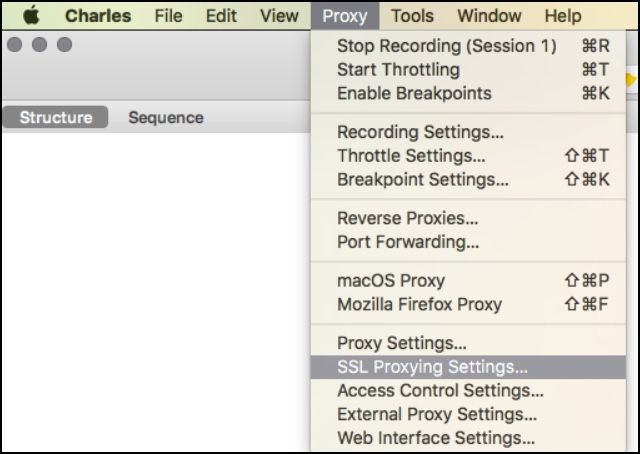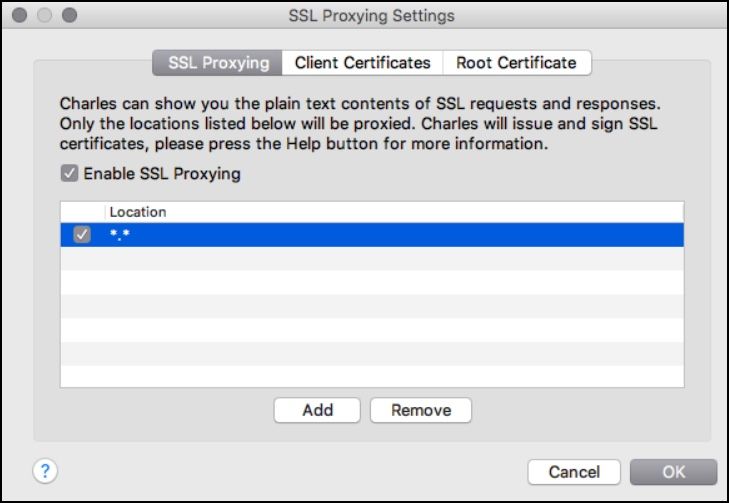This article describes the steps required to set up your Android device to proxy network requests through Charles.
Configuring Charles Proxy
Use the following steps to configure Charles Proxy:
- Go to Proxy > Proxy Settings.
- In the Proxies tab enter
8888in the HTTP Proxy Port field. - Go to Proxy > SSL Proxying Settings.

- Click the SSL Proxying tab and check the Enable SSL Proxying checkbox to configure a location.
By default, Charles will only perform SSL proxying for specific domains you include in the list.
To save listing all URLs you wish to inspect, you can use a location of*.*as a wildcard, and SSL proxying will be enabled for all domains:
If your app ceases to function correctly, it is possible that the app is rejecting the self-signed certificate from Charles Proxy. If this happens, disable the wildcard match, and list only the domains. - The port default value is
443.
You can leave this field blank, as Charles will set it automatically.
Identifying Your IP Address
- Go to Help > Local IP Address

- Make note of the IP Address, as it will be needed in later steps.
Configuring Your Android Device to use the Charles Proxy
Use the following steps to configure your Android device to use Charles proxy:
- Go to Settings > Wifi.
- Press and hold down the power key on the Wifi Network device you are currently connected to.
- When the modal displays, select Modify Network.
- Select Show Advanced Options to display proxying options.
- Under Proxy, select Manual.
- In the Proxy Host Name box, enter the IP Address you previously saved from your development machine.
- In the Proxy Port field, enter
8888, as when configuring Charles. - Click Save to save the settings and exit.
- Open a browser on your device to test.
Charles displays a dialog prompting you to allow or deny SSL proxying. - Click Allow.
If you are not prompted to allow SSL proxying, restart Charles and try again. - Go to
http://chls.pro/sslfrom your device and download the Charles SSL certificate.
On newer versions of Android, you may get an error on downloading, such as “download unsuccessful”.
If this happens, use the following instructions:
- Go to Help > SSL Proxying > Save Charles Root Certificate.
- Change the file type from the default
.pemto.cerand save in a location that you will remember for later. - Transfer the
.cerfile to your device using an SD Card, USB Cable, or remote transfer such as Google Drive. - Open the file from a file manager such as the Android File Manager, or a third party file manager such as File Commander.
You will be prompted to save the certificate. - Continue with the remaining steps.
- Name the certificate and okay it as a trusted certificate.
Ensure that you disable or remove it when complete. - Once the certificate is installed, you are prompted to set up a PIN.
- When prompted, add the new PIN.
Clearing Certificates and Removing the PIN from a Device
Clearing the certificate and removing the PIN from an Android device is optional.
Use the following steps to clear the certificate, remove the PIN, or both:
- Open the Settings application on your Android device.
- Navigate to Security > Clear Credentials at the bottom of the list of options.
- Click Clear Credentials.
- Confirm that you want to clear the credentials.
- To remove the PIN, navigate to Settings > Lock Screen > Screen Lock and remove the PIN.
Source: